Wider World
Feature
Food
Feature
Vilna’s Yiddish Kitchen Reborn
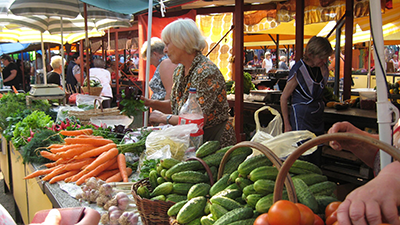
In the old days, Jewish boys in Eastern Europe began their religious studies at the tender age of 3. On the first day of school, the pages of their books would be sprinkled with sugar, to demonstrate that learning is sweet.
I’ve always been charmed by that custom, and when I attended a Yiddish summer program in Vilnius, the capital of Lithuania, my fellow students and I decided that we would sweeten our studies, too. To do so, we turned to the newly updated and translated version of Fania Lewando’s The Vilna Vegetarian Cookbook: Garden-Fresh Recipes Rediscovered and Adapted for Today’s Kitchen, originally published in Yiddish in 1938.
Every summer, the four-week Yiddish language and literature program at Vilnius University’s Yiddish institute draws dozens of students from all corners of the globe. Some come for the university credits; others, like me, simply yearn to immerse ourselves in the mother tongue that once resounded in kitchens, factories, market squares and meeting halls on both sides of the Atlantic.
The program is intense, and we had lots of homework—page after page of grammar exercises and mountains of reading, from Sholom Aleichem and I.L. Peretz to Kadya Molodowsky and Isaac Bashevis Singer. Even so, we students decided to give ourselves an extra assignment, a culinary one. Each of us would pick a recipe from the Vilna Vegetarian Cookbook. We had 400 salads, soups, latkes, stews, blintzes, omelets, pickles, kugels, puddings, dumplings, jams, cookies, cakes and sorbets to choose from, all of them pareve or milchig and most firmly grounded in the tradition of East European cuisine. We would shop for ingredients at local markets, prepare the food in our dorm or apartment kitchens and bring the cooked dishes to a feast at the end of the month.
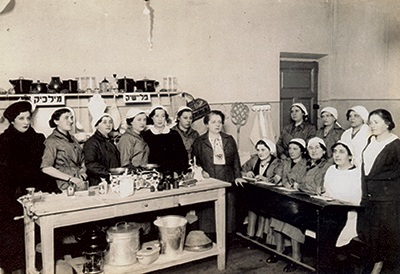
Oh, and one more thing: At the feast, each of us promised to describe the dish and how we made it—in Yiddish.
We had only a single copy of the cookbook to pass around, but we made do. When it was my turn, I spent hours poring over the recipes and the ample background material. I learned that Lewando (1889-1941) was a culinary legend in her time. She owned a renowned vegetarian kosher restaurant on the street that Jews called Daytshe Gas (German Street), now officially known by its Lithuanian name, Vokieciu Gatve. Excerpts from the restaurant’s guestbook, placed at the back of the cookbook, include glowing testimonials from Marc Chagall, Itzik Manger and other artistic and literary celebrities.
Down the block, Lewando ran a cooking school where she taught housewives how to prepare the vegetarian dishes she touts in her book as “far healthier and more suitable for the human organism” than those containing meat or fish. Lewando’s recipes also had (and have) the virtue of being economical. For many in this region before the war, a diet short on meat was a matter of simple necessity. And restrictions on the koshering of meat at that time made the recipes even more useful.
Lewando and her husband, Lazar, an egg merchant, disappeared in 1941. According to witnesses, they were taken captive by Soviet soldiers while trying to flee the Nazi occupation. The cookbook, too, disappeared, but in 1995 a copy turned up at a rare-book sale in the United Kingdom and was donated to YIVO Institute for Jewish Research in New York. With its charming, colorful illustrations of vegetables from leeks and carrots to cabbage and cucumbers—based on seed packets labeled in Yiddish and English—and its straightforward descriptions of how to prepare simple, healthful food, the book was an obvious treasure.
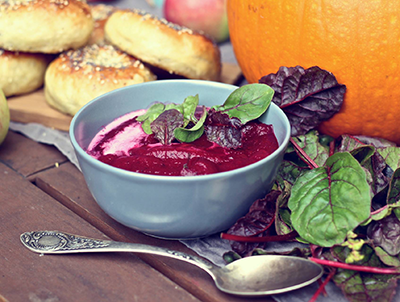
The perfect match was made when Eve Jochnowitz, a veteran Yiddishist and food expert, agreed to translate the book. Jochnowitz tested many of the recipes and adapted them for today’s kitchen. She converted the original measurements from decagrams to cups and added helpful, witty annotations. She was careful to preserve Lewando’s clear, direct voice—and her strict commands. “Prepare everything precisely as instructed in the recipes,” Lewando orders sternly in her introductory note, entitled “To the Housewife: A Few Words and Practical Advice.”
During World War II, Lewando’s restaurant and cooking school were destroyed, along with her community’s synagogues, libraries, theaters and schools. Tens of thousands of Jewish residents were killed. After the war, the Soviet government suppressed Jewish culture, and when emigration opened up in the 1970s, Jewish heritage deteriorated further. Today, Vilnius is home to almost 3,000 of Lithuania’s 4,000 Jews.
As I walked through the narrow, curving streets in the land of my Jewish forebears, it was difficult to imagine the days when the air rang with the sounds of Yiddish along with Polish, Russian, Belarusian and Lithuanian, as people of different cultures lived together in relative harmony. Studying Yiddish helped. Walking tours of the old Jewish quarter and visits to the Jewish museum helped, too. Every Friday night at the Jewish community center, we Yiddish students and our teachers joined with local residents and foreign visitors to create a Shabbes tish (Sabbath table) with candles and songs. And, as I had during past visits, I sought out the Jews and non-Jews devoted to building tolerance; their work filled me with hope for the future.
And food helped me honor my ties to this place. I made a beeline for the city’s 100-year-old markets—the Hales market near Old Town and the Kalvariju market located across the Green Bridge in the old neighborhood the Jews called Snipishok (Snipiskes in Lithuanian). Lewando’s recipes danced before my eyes as I threaded my way through aisles heaped with mushrooms, carrots, potatoes, berries and melons. Should I try my hand at preparing the bright pink beet soup served at virtually every restaurant in town? Maybe Lewando’s mushroom broth with noodles? Or her fresh chanterelle pudding? I bought buckwheat groats (kasha) and onions, a head of cabbage, a bunch of fresh dill and small, knobby cucumbers. Especially intriguing were the unfamiliar fruits known as balloon berries, a cross between strawberries and raspberries. Simmered with sugar as Lewando suggests, the berries made a fantastic compote.
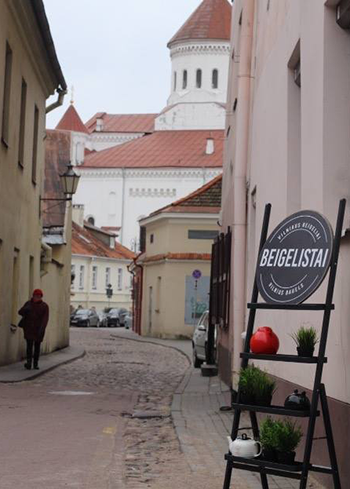
One day in class, I gave a short talk based on Lewando’s recipe for kvass, a centuries-old drink prepared from fermented bread. “Nemt tsvey labns broyt,” I began: Take two loaves of bread, cut them into small pieces and fry until crisp. Soak in hot water, strain through a sieve and add sugar and yeast….
I didn’t try making kvass myself, but I did buy a bottle at the grocery store. Some describe the taste as that of a supremely yeasty beer. To me, it tasted like Coke. Most of Lewando’s recipes are easy to prepare, but this one and a few others (preserved eggs, for example) are mainly of historical interest. But I swear I’m going to attempt her homemade sauerkraut.
It took me a long time to decide what to bring to the feast. The night before the big event, for reasons I can’t fully explain, it was close to midnight when I got to work on my Egg Cookies (Eyer Kikhlekh). Unfortunately, I’d given the cookbook to a fellow student without remembering to copy the recipe, but I pretty much had it in my head: five cups of flour, four eggs, half a cup of vegetable oil, three tablespoons of sugar. I turned on the oven (wondering a little about the strange symbols on the dial) and mixed the dough. I turned a drinking glass on its side to serve as a makeshift rolling pin.
Around about then, I realized that I would not be following Lewando’s directions “precisely as instructed” after all. So, I threw in some lemon juice for extra flavor. Then I used the floured rim of the glass I had used as a rolling pin to cut out circles of dough and arranged them on a baking sheet. Then, adding a personal touch, I sprinkled the rounds with poppy seeds and dried rosemary.
While the apartment filled with a heavenly aroma, I practiced my Yiddish: mel, flour. Eyer, eggs. Boyml, oil. Mon, poppy seeds.
The cookies actually weren’t bad, especially if you thought of them as biscuits or crackers.
As it turned out, every one of my fellow cooks had—defiantly?—taken liberties with Lewando’s instructions. The results were delicious. Arrayed on our classroom desktops that day were plates of eggplant appetizers, trays of roasted potatoes sprinkled with fresh dill and parsley, a tureen of Ukrainian borscht (minus Lewando’s suggested flour, butter and sour cream), varenikes (not from the cookbook, but from someone’s mother’s recipe), cucumber salad, strawberries with cream and an apricot sauce with almonds that made a perfect topping for my egg cookies.
There were bagels, too, from Vilnius’s new bagel bakery.
After we had described our dishes in enthusiastic if occasionally ungrammatical Yiddish, we broke out into a lusty rendition of “Bulbes,” the Yiddish song about an unremitting diet of potatoes (“on the Sabbath, for a treat, potato kugel”). Then we raised our glasses to Fania Lewando, to our beloved Yiddish language and to a historic city that carries the burden of a glorious and tragic Jewish past.
Egg Cookies
Make a soft dough of 5 cups flour, 4 eggs, 1/2 cup [vegetable] oil and 3 tablespoons sugar. Roll it out into a thick sheet and cut into cookies with a glass. Spring a baking sheet with a little flour, put the cookies on it, brush with egg[wash] and bake in a hot oven about 10 to 12 minutes.
Rice with Apples
Follow package directions, cook 1 1/2 cups rice in 3 cups water until soft and rinse in a colander with cold water. Add 2 grated apples, 1 cup raisins, 1/4 teaspoon almond extract, a bit of cinnamon, 12 tablespoons butter and 4 tablespoons sugar. Mix well and bake 30 minutes. Serve with plum sauce. Lewando suggests, for the New Year, substituting honey for some of the butter.
Noodle Kugel with Nuts
Prepare one, 10-ounce package of medium noodles according to package’s directions, then drain. Mix 4 tablespoons sugar, 1 cup ground walnuts, 1/2 cup plus 1 tablespoon melted butter, 4 ounces chopped figs, the juice of 1 lemon, grated zest of 1/2 lemon and 2 eggs. Grease a kugel pan with butter, sprinkle with bread crumbs and add the batter. Fill a larger baking dish with water and place the kugel pan in the water bath. Bake until brown. (You can also include this in a cholent.)
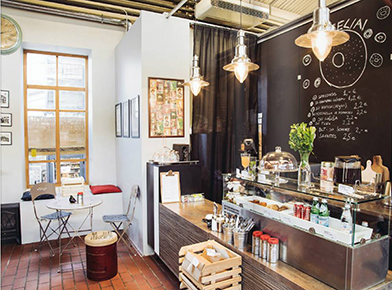
Bagels Are in the Air
Not far from the old Jewish quarter in Vilnius, the Beigelistai shop sells pastries, coffee drinks and bagels with a choice of toppings, some quite Jewish—salmon and cream cheese, hummus—and some far less so, such as ham and cheese. Beigelistai’s success has been impressive: The first location, the one near the Jewish quarter, has spawned two more outposts.
Owner Nomeda Kuodiene got the idea for a bagel bakery when she tasted her first bagel on a visit to New York. From the start, she understood the vital balance of the dense, chewy inside and the crusty outside. She spent months experimenting with various flours and techniques. “It’s been a long, long journey,” she said.
The bagels are prepared on site in the original store’s tiny kitchen: boiled, brushed with a delicate wash of honey, sprinkled with poppy and sesame seeds, then baked.
Bagels are in the air these days. The Jewish community in Vilnius has launched an outreach program designed to increase young Lithuanians’ appreciation for Jewish heritage. Its name? Bagel Shop.









 Facebook
Facebook Instagram
Instagram Twitter
Twitter
McDougal says
Great stuff, Vilnius is an ancient Lithuanian capital city, where many foreign cultures found their new home and became locals. Lithuania appreciates every culture that contributes to Lithuania’s prosperity. Hopefully, Lithuanian youth will be interested in the Jewish heritage as well as the Jewish youth will be interested in the Lithuanian heritage.
Monica (Bankevicius aka Banky) Harwood says
My paternal Jewish grandfather, Miklovas Bankevicius, immigrated from Lithuania in the early 1900s. He originally came to New York but settled in Chicago, converted to Catholism, when he married my grandmother, Ona. The story goes that someone from his NY family found him & begged him to return to NY. Always curious if there r any related relatives in NY. Nonetheless, the food was delicious. Glad to know a real bagel place exists in Vilnius. Bought Lithuanian rye bread shipped in fr Vilnius this Spring when I was in Chicago & suris. Yum
Nancy Friedman says
where can i order this book
Nancy Friedman says
where can i order book A Yiddish Kitchen Reborn by Ellen Cassidy
Libby Barnea says
The book is called The Vilna Vegetarian Cookbook. You can order it from Amazon https://www.amazon.com/Vilna-Vegetarian-Cookbook-Garden-Fresh-Rediscovered-ebook/dp/B00N6PEVBK/ref=sr_1_1?s=books&ie=UTF8&qid=1481549883&sr=1-1&keywords=the+vilna+vegetarian+cookbook
Marny CA says
My mom was born in Vilna Geberna – and came to the USA in 1920. She told some stories to me when I was a teen (1950s) about being poor and taking some potatoes to the fish monger and begging for some herring juice to mix with the potatoes.
She was an excellent cook but had to contend with working 2-3 jobs – to support us – so didn’t have a lot of time to devote to cooking. I used to watch her on some of her meal preparations – so *can* clean a kosher chicken, can scrape the carrots the way she did, can make chicken soup just like she made it – and can make her pot roast, but not her stuffed cabbage – *can* make chopped liver the say she did – but cannot make the chopped herring. It’s for sure I can’t make her kishkah – no one can! Better than delicious. I miss her. She died on Yom Kippur 1984.